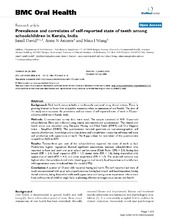Prevalence and correlates of self-reported state of teeth among schoolchildren in Kerala, India
Journal article
Published version
Permanent lenke
https://hdl.handle.net/1956/1922Utgivelsesdato
2006-07-03Metadata
Vis full innførselSamlinger
Originalversjon
https://doi.org/10.1186/1472-6831-6-10Sammendrag
Background: Oral health status in India is traditionally evaluated using clinical indices. There is growing interest to know how subjective measures relate to outcomes of oral health. The aims of the study were to assess the prevalence and correlates of self-reported state of teeth in 12-year-old schoolchildren in Kerala, India. Methods: Cross-sectional survey data were used. The sample consisted of 838 12-year-old schoolchildren. Data was collected using clinical examination and questionnaire. The clinical oral health status was recorded using Decayed, Missing and Filled Teeth (DMFT) and Oral Hygiene Index – Simplified (OHI-S). The questionnaire included questions on sociodemographics, self reports of behaviour, knowledge and oral problems and a single-item measuring self-reported state and satisfaction with appearance of teeth. The Kappa values for test-retest of the questionnaire ranged from 0.55 to 0.97. Results: Twenty-three per cent of the schoolchildren reported the state of teeth as bad. Multivariate logistic regression showed significant associations between schoolchildren who reported to have bad teeth and poor school performance (Odds Ratio (OR) = 2.5), having bad breath (OR = 2.4), food impaction (OR = 1.7) dental visits (OR = 1.6), being dissatisfied with appearance of teeth (OR = 4.2) and caries experience (OR = 1.7). The explained variance was highest when the variables dental visits, bleeding gums, bad breath, food impaction and satisfaction with appearance were introduced into the model (19%). Conclusion: A quarter of 12-year-olds reported having bad teeth. The self-reported bad state of teeth was associated with poor school performance, having bad breath and food impaction, having visited a dentist, being dissatisfied with teeth appearance and having caries experience. Information from self-reports of children might help in planning effective strategies to promote oral health.
